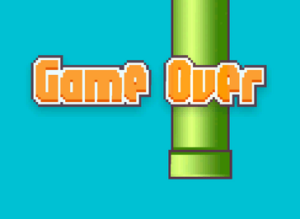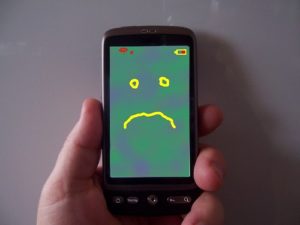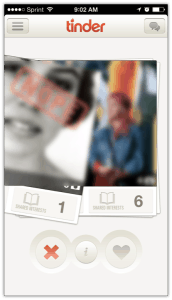The Secret Psychology of Snapchat
You’ve undoubtedly heard of Snapchat, the habit-forming messaging service used by over 100 million people monthly. This week, I teamed up with Victoria Young and Dori Adar to help explain what makes the app so sticky.
We decided that instead of writing a long blog post, we’d share our insights in a slide presentation.
Related Articles
- Studies Show Self-Compassion is the Motivator You’re Missing
- How to Banish Virtual Meeting Boredom
- Limiting Beliefs: Ditch the 4 Dream Killers Holding You Back
- Sales Psychology: Why You Make Terrible Buying Choices
- Listening to Fitness Gurus is Making You Fat
- The Magic of Now, Not How
- The App that Transforms Drinking Habits: a Case Study
- 3 Steps to Master Your Emotions and Be Your Best Self
- The Ultimate Guide to Unstoppable Motivation
- Multitasking During Meetings? How to Make Your Colleagues Indistractable
- How to Build a Habit-Forming Enterprise Product
- Score Your Spats: How to Stop Arguing and Enhance Your Relationships
- Unlocking Focus with the Distraction Tracker
- The Crucial Difference Between Distraction and Diversion
- Decoding Self-Serving Bias: A Spy’s Guide to Clear Thinking
- This Meeting Could have Been an Email: From Time Suck to Unstuck
- When Do You Feel Most Creative? Why Ideas Bloom at Bedtime
- 32 Morning Affirmations: Rise & Shine! [Science-Backed]
- Scheduling for Life’s Surprises: When Timeboxing is Toast
- Messaging App Madness: How To Stay Productive [and Sane]
- How to Build an Irresistible Product for VC Investors
- You Don’t Have to Follow the Same Routines Forever
- You Can Have Your Retirement Fantasy Today
- How to Craft an ‘Indistractable’ Summer Schedule for Your Kids
- The 4-Day Workweek: How To Do More With Less
- Managers, Stop Distracting Your Employees
- Here’s How I Made the Time to Write 2 Bestselling Books
- A Case Study in Implementing the Hooked Model: Gatorade’s Gx App
- Money Buddies: Don’t Go It Alone with Your Wallet
- 5 Productivity Myths Ruining Your Life
- 6 Habits That Are Secretly Making You Miserable
- One Question to Ask Yourself to Know Your Future
- Make Time for Procrastination
- People Make Time for What They Want — Rightfully So
- Kickstart the New Year with a Self-Audit
- ’Tis the Season for Reexamining Your Values
- 4 Mental Traps That Kill Productivity
- Labeling Yourself is Keeping You Down, Do This Instead
- Not Enough Hours in the Day To Slay Your To-Do List
- 3 Reasons Why Subscription Businesses Fail
- Skip the Digital Detox—Abstinence Won’t Work (But This Does)
- The Surprising Science of “Manifestation”
- Best Productivity Tools: 6 That Stuck With Me
- Schedule Maker: a Google Sheet to Plan Your Week
- A Fail-Safe Trick in your Search for the Right Productivity Apps
- You’re Not Addicted to Technology. Here’s What’s Happening Instead.
- Locus of Control: How It Affects Your Life and How To Manage It
- Distraction at Work Is a Symptom of Dysfunction
- 8 Productivity Hacks You Can Do in 30 Minutes
- Why Values In a Relationship Are What Make It Last (Or Not)
- Why People See Problems Where There Are None
- 3 Ways to Filter Your Friends
- How Products Shape Our Mindsets and Change Our Reality
- How to Prevent Burnout Using Timeboxing
- How to Embrace, Not Fear, Being Alone
- Get Comfortable With Being Uncomfortable
- Surprise! There’s a Right Way to Multitask
- Can Someone with ADHD be ‘Indistractable’?
- Planning a Vacation Is Practice for a Great Life
- Why It’s So Hard to Shake the Way People Make You Feel
- Don’t Write About What You Already Know — Instead, I’m “Writing To Learn”
- Are We Really Having Fun at Bars or Just Escaping Reality?
- The 6 Behavioral Design Books That Paved My Career
- The 4 Steps to Becoming Indistractable
- Why You’re Never Going to Be Satisfied With Life
- How a Morning Brain Dump Helps You Stay on Track All Day
- The Key to Behavior Change is Identity Change
- How to Make Sure Working From Home Doesn’t Mean You’re Always Working
- Planning Ahead Is the Key to Living With More Spontaneity
- To Fix Your Problems, Find the Root Cause
- One Question to Help You Get More Done
- The Pursuit of ‘Flow’ Is Overrated
- How to Survive in a World of Information Overload
- How to Get a Friend to Put Away Their Phone Without Being a Jerk
- How to Tame Your Wandering Mind and Actually Get Some Work Done
- If You Don’t Plan Your Time, Someone Else Will
- You Don’t Need a Mentor. You Need a Buddy.
- Would You Rather Give Up Sex or Your Phone?
- Habit Tracker in Google Sheets – Free Template
- Here’s How to Ensure Your Kids Don’t Spend the Entire Break Staring at Screens
- I Changed My Mind About Saying “Merry Christmas,” and You Should Too
- How the Ancient Greeks Beat Distraction
- Habits Are Overrated
- Need Motivation? Make a Price Pact
- Researchers Say We’re Trapped in a “Cycle of Distraction.” Here’s How to Break Free.
- The Pinky Promise: Stick To It – Or Shed Some Blood
- Tame Daily Distractions With a ‘Precommitment Pact’
- “Digital Body Language” Is Everything: Interview with Erica Dhawan
- Good News! Your Willpower Isn’t Limited–Don’t Believe the “Ego Depletion” Theory
- Getting Over FOMO, the Fear of Missing Out
- Choice Architecture: Your Decisions Aren’t Entirely Yours (Interview with Eric Johnson)
- The New Norms of Business: Interview with Nathalie Nahai
- How to Play The Long Game: Interview with Dorie Clark
- Here Are The 4 Simple Introspection Steps That Will Boost Self Awareness
- Can’t Seem to Stick With Your Commitments? Try Making a Pact.
- The Real Reason Why You Sabotage Your Own Goals
- How to Stay on Schedule Even When You Go Off Track
- Stop Thinking About Your Bad Habits! [Do This Instead.]
- Steal These 3 Advertising Secrets–To Use As Motivation Hacks
- How to Escape the Vicious Cycle of Distraction
- A List of 20 Values [and Why People Can’t Agree On More]
- Can We Please Stop Calling Everyone “Addicted”?
- Why Do People Believe the ‘Social Media is Mind Control’ Myth?
- Timeboxing: Why It Works and How to Get Started in 2024
- Children and Technology: 3 Things Parents Need To Know
- The Influencers Dinner: An Interview with Jon Levy
- What Is Motivation? You’ve Probably Been Thinking About It All Wrong
- “Just Say No” Is Bad Productivity Advice
- The New York Times Uses the Very Dark Patterns it Derides
- Can We Regulate Social Networks To Curb Addiction—Without Making Them Suck?
- So, You Want To Become a Great Product Manager? [Q&A with Jackie Bavaro]
- Why the Illusion of Control Is Hurting Your Goals
- Are You a Wage Slave?
- What is the Opposite of “Distraction?” The Single Word that Will Change Your Life This Year
- Don’t Fall for This Excuse Trap: Why “That Won’t Work for Me” is Self-Sabotaging
- Maybe Social Media Isn’t Making Teens Depressed, After All. And Here’s What Likely Is.
- Will Clubhouse be a Habit or Has-Been?
- How to “Listen Like you Mean It”
- Smartphone Too Distracting? Here’s How to Reclaim Your Focus
- “Tech Addiction” Is the New Reefer Madness
- Love is Measured By the Benefit of the Doubt: The Secret to True Kindness
- An Illustrated Guide to the 4 Types of Liars
- Why You Might Need a Humor Audit: the Benefits of Laughter
- Hypocrites: How to Survive in a World that’s Full of Them
- How to Finally Find the Motivation You’ve Been Missing
- Ashley Stahl: Former National Security Expert Helps Us Get Unstuck
- David Burkus: The One Thing Remote Leaders Need to Know
- Hindsight Bias: Why You Make Terrible Life Choices
- How to Turn Off Harmful Stress Like a Switch
- Review of The Social Dilemma: No, Social Media Is Not “Hijacking” Your Brain
- This is How the Media is Misleading You on “Technology Addiction”
- Be a Schedule Builder, Not a To-Do List Maker
- Handling Life Transitions: Interview with Bruce Feiler
- Indistractable Schedule Maker Tool
- Screen Time for Kids: Give Them What They Need
- Changing Habits: Interview with Dr. Amy Bucher, a Behavior Change Designer
- From Friday Forward to Monday Motivation: Q&A with Robert Glazer
- Email Management: How to Hack Back and Cure Inbox Insanity
- The Surprising Benefits of Unconditional Positive Regard
- How to Raise Distraction-Free Kids
- How to Get the Most Out of Your Calendar
- Extrinsic Motivation: Why You Make Terrible Life Choices
- Don’t Follow Your Gut (and What to Do Instead)
- Why You Don’t Have to Be a Rocket Scientist to Think Like One
- Why We Should All Be Wearing (and Making) Face Masks Right Now
- [Survival Tips] Homeschooling During Coronavirus Closings
- Why You’re Not Good at Changing Minds (and What You Can Do About It)
- This is How to be Less Distracted By Having Fun in Tedious Tasks
- “Addicted” to Technology? Why You Need To Turn The Tables And Hack Back!
- What You Need to Know When Visualizing Your Goals
- This is What Most People Get Wrong About Willpower
- Is Tech Ruining Kids? How to Safely Manage Screen Time
- 5 Ways to Distraction-Train Your Mind
- Here Is How to Practice Stillness and Increase Focus
- This is How to Repair a Toxic Work Culture
- How to (Finally) Put an End to Pointless Arguments
- Progressive Extremism: How To Be A Better You
- The Most Important Skill of the Future is Being ‘Indistractable’
- How To Disarm Internal Triggers and Improve Focus
- This Is The Most Important Skill Parents Should Teach Their Kids
- How to Master Hard Skills Quickly with “Ultralearning”
- The Addictive Products Myth: Who Is the Culprit Here?
- 1 Thing You Need To Know To Save You From Your Email Inbox
- If Tech Is So Distracting, How Do Slack Employees Stay So Focused?
- Stop Confusing Habits for Routines: What You Need To Know
- Learn How To Avoid Distraction In A World That Is Full Of It
- [Focus Guide] How To Make The Most Out Of Your Time And Your Life
- The One Fitness App That Hooked Me For Good
- The Truth About Kids and Technology: Jean Twenge (iGen) and Nir Eyal (Hooked) Discuss Tech’s Effect on Children’s Mental Health
- Fundamental Attribution Error: Why You Make Lousy Life Choices
- Kids’ Video Game Obsession Isn’t Really About Video Games. It’s About Unmet Psychological Needs.
- Here’s How Fortnite ‘Hooked’ Millions
- The Real Reason Apple and Google Want You to Use Your Phone Less
- How Bad is Tech Use for Kids, Really?
- How Apps Can Shape Your Future Self
- How to Be Indistractable: Video by Nir Eyal
- Peak-End Rule: Why You Make Terrible Life Choices
- How Netflix’s Customer Obsession Created a Customer Obsession
- Distinction Bias: Why You Make Terrible Life Choices
- Want to Design User Behavior? Pass the ‘Regret Test’ First
- Confirmation Bias: Why You Make Terrible Life Choices
- How to Regain Focus at Work by Slaying the Messaging Monster
- How to Trigger Product Usage that Sticks
- Avoiding Bystander Effect: Getting People to Help Each Other
- Hyperbolic Discounting: Why You Make Terrible Life Choices
- Here’s How Amazon’s Alexa Hooks You
- Technology Is Not Hijacking Your Brain (video)
- When Distraction is a Good Thing
- How to Use Psychology to Make Persuasive Video
- Tech Companies are Addicting People! But Should They Stop?
- How to Use Personality Science to Drive Online Conversions
- Technology Is Distracting. Here’s How to Fix It. (Video)
- The Strange Way Being “Good” Hurts Your Willpower
- Research Reveals How to Take a Better Break
- The Unbelievable Future of Habit-Forming Technology
- Why Our Tech Obsession Might Be a Work Obsession
- The Secret Marketing Power of Evolutionary Psychology
- Your Ability to Focus Has Probably Peaked: Here’s How to Stay Sharp
- Don’t Ask People What They Want, Watch What They Do
- How to Achieve Your Goals By Creating an Enemy
- How Cognitive Biases Can Help (and Hurt) Your Business
- What Most People Don’t Know About Behavioral Design
- How to Start a Career in Behavioral Design
- How to Stay Informed Without Losing Your Mind
- What Do You Do When Someone “Steals” Your Amazing Idea?
- The Way You Think About Willpower Is Hurting You
- Your World is Full of Placebo Buttons (and That’s a Good Thing)
- How to Build Technology that Feels Like a Friend
- This Weird Research-Backed Goal Setting Hack Actually Works
- 3 Pillars of the Most Successful Tech Products
- Here’s How to Ethically Manipulate Other People
- How Two Companies Hooked Customers On Products They Rarely Use
- Don’t Let Friendships Starve to Death: Use This Happiness Hack to Keep People Close
- Conquer Distractions With This Simple Chart
- Should We Worry About the World Becoming More Addictive? Q&A with Nir Eyal
- How to Hook Users in 3 Steps: An Intro to Habit Testing
- The Four People Addicting You to Technology
- Die Dashboards, Die! Why Conversations Will Reinvent Software
- “Think Different” is Bad Advice
- The Secret to Sending Emails and Notifications That Work
- Three Steps To Get Up To Speed On Any Subject Quickly
- It’s How You React to Failure that Matters: Why Ego is the Enemy
- How to Win Your Competition’s Customers
- Hooked for Good: How Habit-Forming Products Improve Lives
- Good Products Start With Good Questions
- Why People Check Their Tech at the Wrong Times (and the Simple Trick to Stop It)
- Happiness Hack: This One Ritual Made Me Much Happier
- Who’s Really Addicting You to Technology?
- How to Clear Your Computer of Focus-Draining Distraction
- Human + A.I. = Your Digital Future
- Why ‘Assistant-As-App’ Might Be the Next Big Tech Trend
- People Don’t Want Something Truly New, They Want the Familiar Done Differently.
- Un-Hooked: Increasing Focus in the Age of Distraction
- Would You Take A Bet That Would Change Your Life? Probably Not. Here’s Why
- The Behavioral Economics Diet: The Science of Killing a Bad Habit
- The Mind-Hack I Used to Help My Father Lose Weight
- 4 Ways to Win Your Competitor’s Customer Habits (Slides)
- 4 Cures for Feeling Overwhelmed: A Book Review
- Here’s Why You’ll Hate the Apple Watch (and the Important Business Lesson You Need to Know)
- The Secret Psychology of Snapchat
- Can’t Kick a Bad Habit? You’re Probably Doing It Wrong
- Everything Is Obvious (Once You Know The Answer) Book Review
- Your Fitness App is Making You Fat, Here’s Why
- The Psychology of Notifications: How to Send Triggers that Work
- How Technology Tricks You Into Tipping More
- Building Community Starts with Understanding People
- When Persuasion Becomes Deception
- Latest Tech Trends: Products to Eliminate Distractions and Increase Willpower
- Mastering Pricing Principles
- 3 Ways to Make Better Decisions Using “The Power of Noticing”
- A Handy Behavioral Design Toolkit
- Onboarding Matters – Getting Users Engaged in your Product
- The Limits of Loyalty: When Habits Change, You’re Toast
- Dual Process Theory: Is Your Product the Elephant or the Rider?
- 4 Ways to Use Psychology to Win Your Competition’s Customers
- Web Psychology – The Science of Online Persuasion
- Email Habits: How to Use Psychology to Regain Control
- Developing User Empathy with Design Sprints
- The Real Reason “Stupid” Startups Raise So Much Money
- Want To Be A Game Psychologist? What You Need to Know
- The Psychology Behind Why We Can’t Stop Messaging
- How to Do Effective User Research
- Context Driven Design (The “Context Effect”)
- The Psychology of a Billion-Dollar Enterprise App: Why is Slack so Habit-Forming?
- Writing Copy for Your Reader’s Brain
- Mind Hacking a Book
- Designing Habit-Forming Products
- Framing Reward is as Important as Reward Itself
- Games, Play, and Motivation
- How Scarcity & Impatience Drive Irrational User Behavior
- Habits, Obstacles, and Media Manipulation with Ryan Holiday
- Should You Listen To Your Users or Your Data?
- Emotional Engagement – Designing with the Heart in Mind
- A Free Course on User Behavior
- This Simple Equation Reveals How Habits Shape Your Health, Happiness, and Wealth
- It’s Not All Fun And Games: The Pros and Cons of Gamification at Work
- Product Psychology: The 3 Things Everyone Should Know About
- Getting Traction: How to Hook New Users
- Designing for Behavior Change Book Review
- The Sneaky Trick Behind the Explosive Growth of the Kardashian Game
- The Sweet Spot: Where Technology Meets the Motivational Brain
- The Number One Reason Good Habits Don’t Last
- How Successful Companies Design for Users’ Multi-Device Lives
- The Link Between Habits and User Satisfaction
- What Triggers The Best Word of Mouth Marketing?
- Is Some Tech Too Engaging?
- Can Online Apps Change Real-Life Behavior?
- What Tech Companies Can Learn from Rehab
- Auction Addiction: This Online Industry’s Dirty Secrets
- Teach or Hook? What’s the Real Goal of Online Education?
- Using Mind Control to Raise Startup Cash
- How To Build Habits In A Multi-Device World
- How To Cope with Your Insane Jealousy Of The WhatsApp Deal
- Why Do Fads Fade? The Inevitable Death Of Flappy Bird
- You’d Be Surprised By What Really Motivates Users
- Nostalgia: A Product Designer’s Secret Weapon
- How You Can Help Users Change Habits
- Is “Lean Startup” Right for Your Idea?
- Hunting for Habits: Keying in on smart design to make a product irresistible
- Are Companies Too Obsessed With Growth? How to Measure Habits
- Refresh: The App a Secret Agent Would Love
- Angel or Devil: Who’s Really Investing In Your Start-Up?
- 3 Ways I Use Technology to Find Happiness
- In 10 Years, We Won’t Use Personal Technology
- How to Break 5 Soul-Sucking Technology Habits
- 4 Simple Things I Did to Control My Bad Tech Habits
- The Real Reason You’re Addicted to Your Phone
- “Yes, And”: The Two Words that Created a #1 App
- The Power of No
- From Laid to Paid: How Tinder Set Fire to Online Dating
- What if In-App Purchases Came to Real Life?
- To Become a Superstar, Improve Your Strengths (Not Your Faults)
- Hooking Users One Snapchat at a Time
- How To Save Your Startup From The “Spotlight Effect”
- Bible App: Getting 100M Downloads is Psychology, Not a Miracle
- Why Behavior Change Apps Fail to Change Behavior
- How to Boost Desire Using the Psychology of Scarcity
- Marketplaces & The Curse of the Network Effect
- Today’s Behaviors, Tomorrow’s Startups
- Venture Capital and The Superstitious Investor
- Think You Like What You Like? Think Again
- The Roots of Temptation
- Our More Engaging World
- The Future is Driven by Interface Changes
- Why Business Is Obsessed With Habits
- Viral Loops Or Viral ‘Oops’?
- Making a Marketplace
- Why Positive Thinking is Bad For You
- What Killed Turntable.fm?
- What You Don’t Know About Human Intuition Can Hurt You
- Designing to Reward our Tribal Sides
- New Video – “Hooked: Building Habit-Forming Products”
- This Will Be the Last Article You Read
- How Technology is Like Bug Sex
- Time for Digital Hat Racks
- Ways To Get People To Do Things They Don’t Want To Do
- The Network Effect Isn’t Good Enough
- Escape From Message Hell
- Mass Persuasion, One User At A Time
- How Investment Drives Engagement (Slides)
- Getting Your Product Into the Habit Zone
- Where Have The Users Gone?
- Infinite Scroll: The Web’s Slot Machine
- Designing User Habits Video
- Psychology of Sports: How Sports Infect Your Brain
- This is Your Brain On Boarding: How to Turn Visitors Into Users
- User Investment: Make Your Users Do the Work
- Behavior by Design Video
- When Designing for Good Is Bad
- Stop Building Apps, Start Building User Behaviors
- The Morality of Manipulation
- The Next Secrets of the Internet
- User Growth and Engagement: A Hacker Metric
- Spotting the Next Facebook: Why Emotions are Big Business
- Strange Sex Habits of Silicon Valley
- The Billion Dollar Mind Trick: An Intro to Triggers
- Why Everyone Hates I.T. People
- Hooking Users In 3 Steps: An Intro to Habit Testing
- Abolish The Reference Check
- Variable Rewards: Want To Hook Users? Drive Them Crazy
- How to Design Behavior (The Behavior Change Matrix)
- How To Design For “Normals”
- The Hooked Model: How to Manufacture Desire in 4 Steps
- User Habits: Why Startups Must Be Behavior Experts
- What Is, and Is Not, Your Product’s Job
- Forming New Habits: Train to be an Amateur, Not an Expert
- Personalized eCommerce Is Already Here, You Just Don’t Recognize It
- Pinterest’s Obvious Secret
- Where is the Web Going?
- The Developer Divide: When Great Companies Can’t Hire
- Being a Quitter Makes You a Good Entrepreneur
- Why Your Goals Will Fail, and What You Can Do About It
- Behavior by Design
- What A-Players Do That You Don’t
- Why You Should Run Your Business Barefoot
- Are you a Startup Star, Wacko, or Wannabe?


 Do you constantly check your smartphone to see if you’ve received messages or notifications on Facebook? Does your phone distract you from your studies or work? Do your friends, parents, children, or spouse complain that you are not giving them enough attention because of your phone? You may be addicted to your phone.
Do you constantly check your smartphone to see if you’ve received messages or notifications on Facebook? Does your phone distract you from your studies or work? Do your friends, parents, children, or spouse complain that you are not giving them enough attention because of your phone? You may be addicted to your phone. Tinder
Tinder